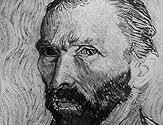Añade un argumento en tu idiomaThe biography of Dutch artist Van Gogh, illustrated only with images of his paintings and drawings, or details of those, and according dramatic musical score.The biography of Dutch artist Van Gogh, illustrated only with images of his paintings and drawings, or details of those, and according dramatic musical score.The biography of Dutch artist Van Gogh, illustrated only with images of his paintings and drawings, or details of those, and according dramatic musical score.
- Dirección
- Guión
- Reparto principal
- Ganó 1 premio Óscar
- 2 premios en total
Reseñas destacadas
Ok, so first things first. Why would you make a documentary on this most vibrant and vivid colourist in monochrome? Well, I can't swear this was the reason but watching this compendium of some of his finest works of art actually works. Somehow by filtering out the colour, we focus more on the intricacies of his brushwork, the intensity of the characterisations - frequently himself; the definition that ranges from the detailed and intricate to the more abstract and generic. You can almost see between the hairs on the brush at times, then there is a density that even in black and white still proves evocative as the beautiful scenery and lifelike and natural people almost come alive before us for twenty minutes. I didn't love the score, and some of the camerawork seemed determined to create a sense of frenzy rather than just let our own eyes do that, as required, but watching it through this unfamiliar lens is intriguing and worth a look.
The key events of Vincent Van Gogh's life are narrated (by Claude Dauphin in the French version, and by Martin Gabel in the English), and illustrated by the paintings, with appropriately heightened music score attached. That's it...and that's certainly enough, given the extraordinary interconnection of this particular artist's private life and his career. I have to say that it's extremely puzzling, not to say disturbing, that the entire film is in black-and-white, as if Van Gogh had made only charcoal sketches or woodcuts. Here's a short that cries out to be remade: Digital would make it easy to replace the B&W footage with color photography of the artworks, and both narration and score could remain as is. I was also dismayed that though the film has credits attached, Resnais's name does not appear on the English language print owned by UCLA and screened at the Motion Picture Academy last night. The audience seemed interested and moved, but surely they would have been more so if they'd known that this was an early work by the man who later employed many of the same techniques to memorable effect in "Last Year at Marienbad."
Before acquiring a reputation as an elegantly formalist film-maker, Alain Resnais made a series of renowned documentaries some of which centered on the great painters or even individual works (such as Picasso's GUERNICA {1950}); this particular effort – obviously dealing with the tortured Dutch artist – went on to win both an Oscar and a prize at the Venice Film Festival. Van Gogh is perhaps the artist most picked on by the cinema, with at least four other notable films being made about him: the biopics LUST FOR LIFE (1956; the only one I have watched myself), VINCENT & THEO (1990) and VAN GOGH (1991), and the feature-length documentary VINCENT (1987)! This two-reeler, then, opts to tell his tragic life-story solely via narration (spoken by distinguished actor Claude Dauphin) accompanying stills – presumably in roughly chronological order – of the numerous canvases he signed illustrating the places, things and people around him and, of course, including his own famous self-portraits. Though occasionally repetitive and with their natural impact somewhat lessened by the absence of colour, Van Gogh's style is so well-defined (one might safely say that it has been over-exposed over the years) that his unique brushstrokes – no doubt an extension of the man's anguished personality – are instantly recognizable to even casual aficionados of the form!
I saw this on a Japanese DVD with other early Resnais and Godard short films. (The title of the DVD in Japanese is Alain Resnais, Jean Luc Godard tampen kessaku sen. It is easily available in Japan.) The narration of the film was in French, with Japanese subtitles. As the narrator tells about Van Gogh's life, the camera shows Van Gogh's pictures (in black and white) of the house where Van Gogh lived at the time... the camera is constantly moving... you feel as if you are entering the house and moving from room to room as the camera cuts from one picture inside the house to another....an interesting way to describe the life work of an artist. The technique leaves the viewer wanting more.
¿Sabías que...?
- ConexionesReferenced in Century of Cinema: Deux fois 50 ans de cinéma français (1995)
Selecciones populares
Inicia sesión para calificar y añadir a tu lista para recibir recomendaciones personalizadas
Detalles
- Duración20 minutos
- Color
- Mezcla de sonido
- Relación de aspecto
- 1.37 : 1
Contribuir a esta página
Sugerir un cambio o añadir el contenido que falta

Principal laguna de datos
What is the streaming release date of Van Gogh (1948) in Australia?
Responde













